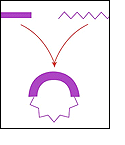Return to Online
Education Kit
|
 |
 |
 Previous Event | Next Event Previous Event | Next Event 
1990: Research on BACs
 In 1990, researchers began to study how to efficiently produce stable carriers of large DNA inserts in bacteria, so-called BACs. In 1990, researchers began to study how to efficiently produce stable carriers of large DNA inserts in bacteria, so-called BACs.
A bacterial artificial chromosome (BAC) is a piece of human DNA fitted into a bacterial "vector", a carrier of DNA. The human DNA insert in BACs – typically 100,000 to 300,000 base pairs long – is more stably inherited than in YACs. Many copies of the human insert are made when the bacteria multiply. They can be used as the pieces of the puzzle when making a physical map of the genome and can be chopped up further for sequencing.
More Information
Reference:
Shizuya, H., Birren B., Kim, U.J., Mancino, V., Slepak, T., Tachiiri, Y., Simon, M. Cloning and stable maintenance of 300-kilobase-pair fragments of human DNA in Escherichia coli using an F-factor-based vector. Proc Natl Acad Sci, 89:8794-7. 1992. [PubMed]
 Previous Event | Next Event Previous Event | Next Event 
Last Reviewed: April 15, 2008
|

